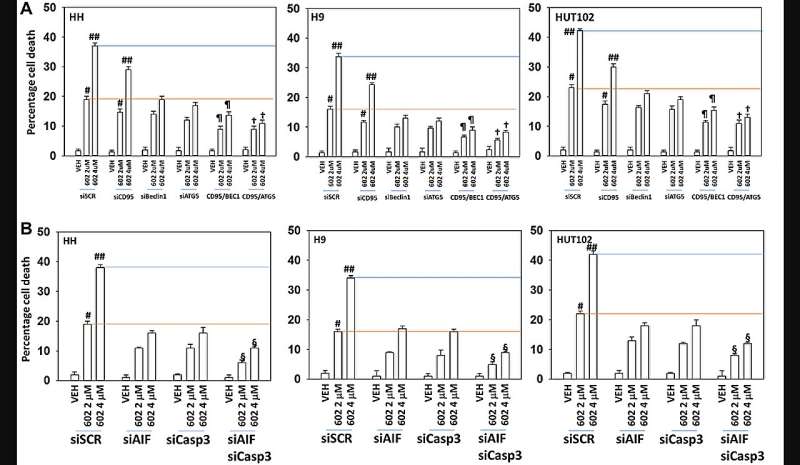This article has been reviewed according to Science X's editorial process and policies. Editors have highlighted the following attributes while ensuring the content's credibility:
fact-checked
peer-reviewed publication
proofread
GZ17-6.02 with bexarotene kills mycosis fungoides cells: Study

A new research paper titled "GZ17-6.02 interacts with bexarotene to kill mycosis fungoides cells" has been published in Oncotarget.
In this new study, researchers Michael R. Booth, Laurence Booth, Jane L. Roberts, Cameron West, and Paul Dent from Virginia Commonwealth University and Genzada Pharmaceuticals investigated the therapeutic agent GZ17-6.02, composed of curcumin, harmine, and isovanillin.
"Combined with our curcumin findings, we believe that isovanillin can complex with curcumin and harmine to create an entity with unique biology when compared to the three individual agents," the researchers write.
GZ17-6.02 has undergone phase I evaluation in patients with solid tumors with an RP2D of 375 mg PO BID. The biology of GZ17-6.02 in malignant T cells, and in particular those derived from mycosis fungoides (MF) patients, has not previously been studied. The researchers found that GZ17-6.02 alone and in combination with standard-of-care agents was effective in killing MF cells.
"All three components are necessary for optimal killing of MF cells," the team says.
GZ17-6.02 activated ATM, the AMPK, NFκB, and PERK and inactivated ERK1/2, AKT, ULK1, mTORC1, eIF2α, and reduced the expression of BCL-XL and MCL1. GZ17-6.02 increased ATG13 S318 phosphorylation and the expression of Beclin1, ATG5, BAK, and BIM. GZ17-6.02 in a dose-dependent fashion enhanced autophagosome formation, autophagic flux, and tumor cell killing.
Signaling by ATM and AMPK were both required for efficient killing but not for the dose-response effect, whereas ER stress (eIF2α) and macroautophagy (Beclin1, ATG5) were required for both efficient killing and the dose-response.
Knockdown of the death receptor CD95 reduced killing by approximately 20% and interacted with autophagy inhibition to further reduce killing, collectively, by approximately 70%. Inhibition of autophagy and knockdown of death medications downstream of the mitochondrion, AIF, and caspase 3 almost abolished tumor cell killing. Hence, in MF cells, the team writes that "GZ17-6.02 is a multi-factorial killer, utilizing ER stress, macroautophagy, death receptor signaling, and directly causing mitochondrial dysfunction."
"We discovered that GZ17-6.02 containing harmine, isovanillin, and curcumin caused more tumor cell killing than any of the agents individually or in pairs and that it could interact in an additive fashion with the standard of care MF drugs such as bexarotene and vorinostat to cause additional tumor cell death," the researchers conclude.
More information: Michael R. Booth et al, GZ17-6.02 interacts with bexarotene to kill mycosis fungoides cells, Oncotarget (2024). DOI: 10.18632/oncotarget.28557




















